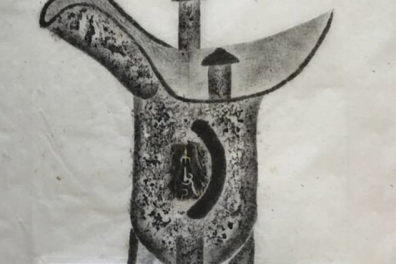Stamping in China: materiality, transmission, reception" study day, March 29

Stamping an inscribed bronze vase, BULAC Collections (BULAC EST618)
Study day organized by Michela Bussotti (EFEO/UMR CCJ) and Lia Wei (Inalco/IFRAE) on the occasion of the exhibition "Pratique de l'estampage : Images et objets inscrits" (March 6-30, 2023, PLC gallery and BULAC garden level) bringing together documents from the École française d'Extrême-Orient (EFEO) and the BULAC.
Wednesday, March 29, 2023 - 09.00-18.00 - PLC (Paris 13e) - room 5.01 and amphitheatre 8 / and online
Inalco - 65, rue des Grands Moulins - 75013 Paris
9am-12pm: room 5.01
12:30pm-6pm : amphi 8
Zoom connection link to attend the event remotely:
https://us02web.zoom.us/j/83986512460?pwd=VDlVN1dsbTZ1TW9kQVdZZmttdFk4dz09
Meeting ID: 839 8651 2460
Secret code : 016887
The invited specialists will present papers on specific stamps or categories of stamps, taking into account not only their textual or pictorial content, but also their material characteristics and the nature of the stamped surfaces, as well as the transmission of these works in ink, from their production to the present day. The day will also be an opportunity to take stock of the study of Chinese stamping and to consider other research perspectives.
Instead of presenting stamping solely as a research medium for the philologist, this project approaches this technique from another perspective: visual and material culture. This is all the more important as the practices surrounding engraved texts (the more a text was copied, the more it became a canon, and stamping contributed to this process), as well as the aesthetic values derived from calligraphy, also apply to the pictorial repertoire and to objects.
Stamping has a value that is autonomous from the stamped stele or object: it is first and foremost a work in ink, and a collector's item in its own right. Inscribed objects - bronzes, bricks... - often acquire value through their circulation in stamped form. In a complicit reciprocity, the engraved object authenticates its stamping, while the ink-on-paper reproduction lends it a certain authority.
Stamping also revisits emblematic genres in the history of Chinese painting: stones and their reproductions carried a variety of images - portraits, landscapes, auspicious motifs...within reach of a wider audience than works on silk or paper.
With the participation of:
- CHASSAING Pauline (Institut National du Patrimoine/PARIS IV);
- DREGE Jean-Pierre (EFEO);
- HATCH Michael (University of Miami);
- JANKOWSKI Lyce (Musée Royal de Mariemont);
- SASSMANN Manuel (University of Heidelberg/Academy of Sciences);
- VENTURE Olivier (EPHE);
- ZHANG Qiang (Sichuan Academy of Fine Arts).
Moderators:
- BAUER Estelle (INALCO/IFRAE);
- BUSSETTI Michela (EFEO/UMR CCJ)
- WEI Lia (INALCO/IFRAE).
Chinese stamps from the EFEO Archives, new research approaches
Discover the new EFEO Asian Treasures video. Michela Bussotti (EFEO), Claude Laroque (Paris I Panthéon-Sorbonne) and Lia Wei (Inalco/IFRAE) discuss the exhibition's conception and new research approaches to the Chinese stamping technique.
View the film
La pierre et le pinceau
A film by Marie-Françoise Plissart
This film was shot in 2010-2011 in Chongqing, in the provinces of Sichuan and Shandong, and in Beijing.
It shows the stamping process in the field, following Lia Wei and Zhang Qiang in their fieldwork in the rock-cut tombs of the Eastern Han dynasty (2nd to 3rd century CE) and the Buddhist epigraphy of the Northern dynasties (6th century CE).
View the film